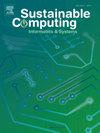一个节能的基于雾的物联网框架,打击野生动物偷猎
IF 3.8
3区 计算机科学
Q1 COMPUTER SCIENCE, HARDWARE & ARCHITECTURE
引用次数: 0
摘要
野生动物贩运是一个重大的全球性问题,其原因是未经证实的医疗主张和可能导致人畜共患疾病的掠夺性生活方式,涉及对濒危和受保护物种的非法贸易。虽然基于物联网的解决方案可以使野生动物监测更加广泛和精确,但它们也有利弊。例如,无人机的覆盖范围很大,但一旦耗尽电力,就无法实时发现偷猎行为。同样,在所有野生动物身上使用RFID项圈也是不切实际的。野生动物监测系统应迅速、警惕和高效。因此,我们提出了一个可扩展的、运动敏感的基于物联网的野生动物监测框架,该框架利用分布式边缘分析和雾计算,不需要与动物接触。该框架包括1;2.运动感应单元(msu);驱动和处理单元(apu)包含一个摄像头、一个处理单元(如单板计算机)和一个伺服电机;包含处理单元的集线器。为了跨这些组件进行通信,使用了ESP-NOW、Apache Kafka和MQTT。然后可以在这些组件上部署定制的应用程序(例如利用ML进行稀有物种检测)。本文详细介绍了该框架的实现,并通过在半森林和茂密森林环境中的测试进行了验证。该系统实现了实时监控,定义为检测运动,转动摄像机,捕获图像,并将其传输到Hub的过程。我们还提供了实现该框架的详细模型,该模型由2800个模拟架构支持。这些模拟优化了基于延迟、成本和能耗的野生动物监测设备选择,有助于保护工作。本文章由计算机程序翻译,如有差异,请以英文原文为准。
An energy efficient fog-based internet of things framework to combat wildlife poaching
Wildlife trafficking, a significant global issue driven by unsubstantiated medical claims and predatory lifestyle that can lead to zoonotic diseases, involves the illegal trade of endangered and protected species. While IoT-based solutions exist to make wildlife monitoring more widespread and precise, they come with trade-offs. For instance, UAVs cover large areas but cannot detect poaching in real-time once their power is drained. Similarly, using RFID collars on all wildlife is impractical. The wildlife monitoring system should be expeditious, vigilant, and efficient. Therefore, we propose a scalable, motion-sensitive IoT-based wildlife monitoring framework that leverages distributed edge analytics and fog computing, requiring no animal contact. The framework includes 1. Motion Sensing Units (MSUs), 2. Actuating and Processing Units (APUs) containing a camera, a processing unit (such as a single-board computer), and a servo motor, and 3. Hub containing a processing unit. For communication across these components, ESP-NOW, Apache Kafka, and MQTT were employed. Tailored applications (e.g. rare species detection utilizing ML) can then be deployed on these components. This paper details the framework’s implementation, validated through tests in semi-forest and dense forest environments. The system achieved real-time monitoring, defined as a procedure of detecting motion, turning the camera, capturing an image, and transmitting it to the Hub. We also provide a detailed model for implementing the framework, supported by 2800 simulated architectures. These simulations optimize device selection for wildlife monitoring based on latency, cost, and energy consumption, contributing to conservation efforts.
求助全文
通过发布文献求助,成功后即可免费获取论文全文。
去求助
来源期刊

Sustainable Computing-Informatics & Systems
COMPUTER SCIENCE, HARDWARE & ARCHITECTUREC-COMPUTER SCIENCE, INFORMATION SYSTEMS
CiteScore
10.70
自引率
4.40%
发文量
142
期刊介绍:
Sustainable computing is a rapidly expanding research area spanning the fields of computer science and engineering, electrical engineering as well as other engineering disciplines. The aim of Sustainable Computing: Informatics and Systems (SUSCOM) is to publish the myriad research findings related to energy-aware and thermal-aware management of computing resource. Equally important is a spectrum of related research issues such as applications of computing that can have ecological and societal impacts. SUSCOM publishes original and timely research papers and survey articles in current areas of power, energy, temperature, and environment related research areas of current importance to readers. SUSCOM has an editorial board comprising prominent researchers from around the world and selects competitively evaluated peer-reviewed papers.
 求助内容:
求助内容: 应助结果提醒方式:
应助结果提醒方式:


